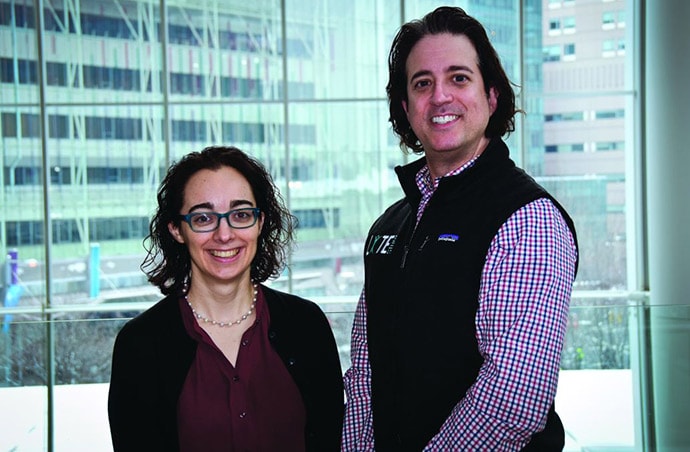Patients with psoriatic disease have significantly higher risks of myocardial infarction, stroke, and cardiovascular mortality than does the general population, yet research consistently paints what dermatologist Joel M. Gelfand, MD, calls an "abysmal" picture: Only a minority of patients with psoriatic disease know about their increased risks, only a minority of dermatologists and rheumatologists screen for cardiovascular risk factors like lipid levels and blood pressure, and only a minority of patients diagnosed with hyperlipidemia are adequately treated with statin therapy.
In the literature and at medical meetings, Dr Gelfand and others who have studied cardiovascular disease (CVD) comorbidity and physician practices have been urging dermatologists and rheumatologists to play a more consistent and active role in primary cardiovascular prevention for patients with psoriatic disease, who are up to 50% more likely than patients without it to develop CVD and who tend to have atherosclerosis at earlier ages.
According to the 2019 joint American Academy of Dermatology (AAD)–National Psoriasis Foundation (NPF) guidelines for managing psoriasis "with awareness and attention to comorbidities," this means not only ensuring that all patients with psoriasis receive standard CV risk assessment (screening for hypertension, diabetes, and hyperlipidemia), but also recognizing that patients who are candidates for systemic therapy or phototherapy — or who have psoriasis involving > 10% of body surface area — may benefit from earlier and more frequent screening.
CV risk and premature mortality rises with the severity of skin disease, and patients with psoriatic arthritis (PsA) are believed to have risk levels similar to patients with moderate-severe psoriasis, cardiologist Michael S. Garshick, MD, director of the cardiorheumatology program at New York University Langone Health, said in an interview.

In a recent survey study of 100 patients seen at NYU Langone Health's psoriasis specialty clinic, only one-third indicated they had been advised by their physicians to be screened for CV risk factors, and only one-third reported having been told of the connection between psoriasis and CVD risk. Dr Garshick shared the unpublished findings at the annual research symposium of the NPF in October.
Similarly, data from the National Ambulatory Medical Care Survey shows that just 16% of psoriasis-related visits to dermatology providers from 2007 to 2016 involved screening for CV risk factors. Screening rates were 11% for body mass index, 7.4% for blood pressure, 2.9% for cholesterol, and 1.7% for glucose, Dr Gelfand and coauthors reported in 2023.
Such findings are concerning because research shows that fewer than a quarter of patients with psoriasis have a primary care visit within a year of establishing care with their physicians, and that, overall, fewer than half of commercially insured adults under age 65 visit a primary care physician each year, according to John S. Barbieri, MD, of the department of dermatology at Brigham and Women's Hospital in Boston. He included these findings when reporting in 2022 on a survey study on CVD screening.
Dr John S. Barbieri, director of the Advanced Acne Therapeutics Clinic at Brigham and Women's Hospital in Boston
In many cases, dermatologists and rheumatologists may be the primary providers for patients with psoriatic disease. So, "the question is, how can the dermatologist or rheumatologist use their interactions as a touchpoint to improve the patient's well-being?" Dr Barbieri said in an interview.

For the dermatologist, educating patients about the higher CVD risk fits well into conversations about "how there may be inflammation inside the body as well as in the skin," he said. "Talk about cardiovascular risk just as you talk about PsA risk." Both specialists, he added, can incorporate blood pressure readings and look for opportunities to measure lipid levels and hemoglobin A1c (HbA1c). These labs can easily be integrated into a biologic work-up.
"The hard part — and this needs to be individualized — is how do you want to handle [abnormal readings]? Do you want to take on a lot of the ownership and calculate [10-year CVD] risk scores and then counsel patients accordingly?" Dr Barbieri said. "Or do you want to try to refer, and encourage them to work with their PCP? There's a high-touch version and a low-touch version of how you can turn screening into action, into a care plan."
Beyond traditional risk elevation, the primary care hand-off
Rheumatologists "in general may be more apt to screen for cardiovascular disease" as a result of their internal medicine residency training, and "we're generally more comfortable prescribing... if we need to," said Alexis R. Ogdie, MD, a rheumatologist at the Hospital of the University of Pennsylvania, Philadelphia, and director of the Penn Psoriatic Arthritis Clinic.

Referral to a preventive cardiologist for management of abnormal lab results or ongoing monitoring and prevention is ideal, but when hand-offs to primary care physicians are made — the more common scenario — education is important. "A common problem is that there is under-recognition of the cardiovascular risk being elevated in our patients," she said, above and beyond risk posed by traditional risk factors such as dyslipidemia, hypertension, metabolic syndrome, and obesity, all of which have been shown to occur more frequently in patients with psoriatic disease than in the general population.
Risk stratification guides CVD prevention in the general population, and "if you use typical scores for cardiovascular risk, they may underestimate risk for our patients with PsA," said Dr Ogdie, who has reported on CV risk in patients with PsA. "Relative to what the patient's perceived risk is, they may be treated similarly (to the general population). But relative to their actual risk, they're undertreated."
The 2019 AAD-NPF psoriasis guidelines recommend utilizing a 1.5 multiplication factor in risk score models, such as the American College of Cardiology's Atherosclerotic Cardiovascular Disease (ASCVD) Risk Estimator, when the patient has a body surface area > 10% or is a candidate for systemic therapy or phototherapy.
Similarly, the 2018 American Heart Association (AHA)-ACC Guideline on the Management of Blood Cholesterol defines psoriasis, along with RA, metabolic syndrome, HIV, and other diseases, as a "cardiovascular risk enhancer" that should be factored into assessments of ASCVD risk. (The guideline does not specify a psoriasis severity threshold.)
"It's the first time the specialty [of cardiology] has said, 'pay attention to a skin disease,' " Dr Gelfand said at the NPF meeting.
Using the 1.5 multiplication factor, a patient who otherwise would be classified in the AHA/ACC guideline as "borderline risk," with a 10-year ASCVD risk of 5% to < 7.5%, would instead have an "intermediate" 10-year ASCVD risk of ≥ 7.5% to < 20%. Application of the AHA-ACC "risk enhancer" would have a similar effect.
For management, the main impact of psoriasis being considered a risk enhancer is that "it lowers the threshold for treatment with standard cardiovascular prevention medications such as statins."
In general, "we should be taking a more aggressive approach to the management of traditional cardiovascular risk factors" in patients with psoriatic disease, he said. Instead of telling a patient with mildly elevated blood pressure, 'I'll see you in a year or two,' or a patient entering a prediabetic stage to "watch what you eat, and I'll see you in a couple of years," clinicians need to be more vigilant.
"It's about recognizing that these traditional cardiometabolic risk factors, synergistically with psoriasis, can start enhancing CV risk at an earlier age than we might expect," said Dr Garshick, whose 2021 review of CV risk in psoriasis describes how the inflammatory milieu in psoriasis is linked to atherosclerosis development.
Cardiologists are aware of this, but "many primary care physicians are not. It takes time for medical knowledge to diffuse," Dr Gelfand said. "Tell the PCP, in notes or in a form letter, that there is a higher risk of CV disease, and reference the AHA/ACC guidelines," he advised. "You don't want your patient to go to their doctor and the doctor to [be uninformed]."
'Patients trust us'
Dr Gelfand has been at the forefront of research on psoriasis and heart disease. A study he coauthored in 2006, for instance, documented an independent risk of MI, with adjusted relative risks of 1.29 and 3.10 for a 30-year-old patient with mild or severe disease, respectively, and higher risks for a 60-year-old. In 2010, he and coinvestigators found that severe psoriasis was an independent risk factor for CV mortality (HR, 1.57) after adjusting for age, sex, smoking, diabetes, hypertension, and hyperlipidemia.
Today, along with Dr Barbieri, Dr Ogdie, and others, he is studying the feasibility and efficacy of a proposed national, "centralized care coordinator" model of care whereby dermatologists and rheumatologists would educate the patient, order lipid and HbA1c measurements as medically appropriate, and then refer patients as needed to a care coordinator. The care coordinator would calculate a 10-year CVD risk score and counsel the patient on possible next steps.
In a pilot study of 85 patients at four sites, 92% of patients followed through on their physician's recommendations to have labs drawn, and 86% indicated the model was acceptable and feasible. A total of 27% of patients had "newly identified, previously undiagnosed, elevated cardiovascular disease risk," and exploratory effectiveness results indicated a successful reduction in predicted CVD risk in patients who started statins, Dr Gelfand reported at the NPF meeting.
With funding from the NPF, a larger, single-arm, pragmatic "CP3" trial (NCT05908240) is enrolling 525 patients with psoriasis at 10-20 academic and nonacademic dermatology sites across the United States to further test the model. The primary endpoint will be the change in LDL cholesterol measured at 6 months among people with a 10-year risk ≥ 5%. Secondary endpoints will cover improvement in disease severity and quality of life, behavior modification, patient experience, and other issues.
"We have only 10-15 minutes [with patients]...a care coordinator who is empathetic and understanding and [informed] could make a big difference," Dr Gelfand said at the NPF meeting. If findings are positive, the model would be tested in rheumatology sites as well. The hope, he said, is that the NPF would be able to fund an in-house care coordinator(s) for the long-term.
Notably, a patient survey conducted as part of exploratory research leading up to the care coordinator project showed that patients trust their dermatologist or rheumatologist for CVD education and screening. Among 160 patients with psoriasis and 162 patients with PsA, 76% and 90% agreed that "I would like it if my dermatologist/rheumatologist educated me about my risk of heart disease," and 60% and 75%, respectively, agree that "it would be convenient for me to have my cholesterol checked by my dermatologist/rheumatologist."
"Patients trust us," Dr Gelfand said at the NPF meeting. "And the pilot study shows us that patients are motivated."
Taking an individualized, holistic, longitudinal approach
"Sometimes you do have to triage bit," Dr Gelfand said in an interview. "For a young person with normal body weight who doesn't smoke and has mild psoriasis, one could just educate and advise that they see their primary care physician" for monitoring.
"But for the same patient who is obese, maybe smokes, and doesn't have a primary care physician, I'd order labs," he said. "You don't want a patient walking out the door with an [undiagnosed] LDL of 160 or hypertension."
Age is also an important consideration, as excess CVD risk associated with autoimmune diseases like psoriasis rises with age, Dr Gelfand said during a seminar on psoriasis and PsA held at NYU Langone in December. For a young person, typically, "I need to focus on education and lifestyle … setting them on a healthy lifestyle trajectory," he said. "Once they get to 40, from 40 to 75 or so, that's a sweet spot for medical intervention to lower cardiovascular risk."
Even at older ages, however, lipid management is not the be-all and end-all, he said in the interview. "We have to be holistic."
One advantage of having highly successful therapies for psoriasis, and to a lesser extent PsA, is the time that becomes available during follow-up visits — once disease is under control — to "focus on other things," he said. Waiting until disease is under control to discuss diet, exercise, or smoking, for instance, makes sense anyway, he said. "You don't want to overwhelm patients with too much to do at once."
Indeed, said dermatologist Robert E. Kalb, MD, of the Buffalo Medical Group in Buffalo, NY, "patients have an open mind [about discussing cardiovascular disease risk], but it is not high on their radar. Most of them just want to get their skin clear." (Dr Kalb participated in the care coordinator pilot study, and said in an interview that since its completion, he has been more routinely ordering relevant labs.)
Rheumatologists are less fortunate with highly successful therapies, but "over the continuum of care, we do have time in office visits" to discuss issues like smoking, exercise, and lifestyle, Dr Ogdie said. "I think of each of those pieces as part of our job."
In the future, as researchers learn more about the impact of psoriasis and PsA treatments on CVD risk, it may be possible to tailor treatments or to prescribe treatments knowing that the therapies could reduce risk. Observational and epidemiologic data suggest that tumor necrosis factor-alpha inhibitor therapy over 3 years reduces the risk of MI, and that patients whose psoriasis is treated have reduced aortic inflammation, improved myocardial strain, and reduced coronary plaque burden, Dr Garshick said at the NPF meeting.
"But when we look at the randomized controlled trials, they're actually inconclusive that targeting inflammation in psoriatic disease reduces surrogates of cardiovascular disease," he said. Dr Garshick's own research focuses on platelet and endothelial biology in psoriasis.
Dr Barbieri reported he had no relevant disclosures. Dr Garshick reported consulting fees from Bristol-Myers Squibb, Kiniksa, Horizon Therapeutics, and Agepha. Dr Ogdie reported financial relationships with AbbVie, Amgen, Bristol-Myers Squibb, Celgene, Eli Lilly, Gilead, GlaxoSmithKline, Janssen, Novartis, Pfizer, Takeda, and UCB. Dr Gelfand reported serving as a consultant for AbbVie, Artax, Bristol-Myers Squibb, GlaxoSmithKline, and other companies.
This article originally appeared on MDedge.com, part of the Medscape Professional Network.



Comments